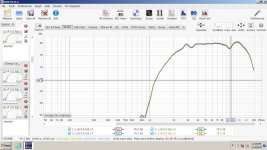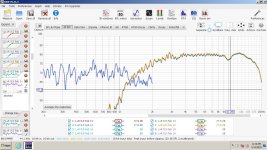I think the idea here is the motor becomes a generator when shorted out. If you close the circuit and then push the cone in you'll create a microscopic amount of current.
This is how the alternator in your car creates electricity to recharge your battery.
By connecting this circuit you are making a miniscule back force against moving the cone.
I'm taking measurements this afternoon. I will try shorting with a gator clip and connecting a separate, non operating but on amplifier and see if there is any difference.
What I just read..."motor...blah, blah, blah, ...shorted, ...blah, blah ...circuit"
You still haven't told be what to do with the alligator clips. As far as I am concerned, I don't have a motor, generator, circuit, etc. I have a speaker driver with two terminals, an amp with two speaker posts, a wooden box, and some alligator clips. What do I do with the alligator clips, my speaker driver, and my amp. I do know that I'm not clipping them to the wooden box. 😂
Yes, just connect the speaker terminals together, + and -.
And guys, last thing I mean to do is insinuate shorting is something we should know about. Heck, we all learn as we go along, right!?
But trust me on this one, it's plain standard operating procedure for measuring active multi-way sections.
And guys, last thing I mean to do is insinuate shorting is something we should know about. Heck, we all learn as we go along, right!?
But trust me on this one, it's plain standard operating procedure for measuring active multi-way sections.
Well, first of all, I didn't suggest this. Second I am just as skeptical as you are.What I just read..."motor...blah, blah, blah, ...shorted, ...blah, blah ...circuit"
You still haven't told be what to do with the alligator clips. As far as I am concerned, I don't have a motor, generator, circuit, etc. I have a speaker driver with two terminals, an amp with two speaker posts, a wooden box, and some alligator clips. What do I do with the alligator clips, my speaker driver, and my amp. I do know that I'm not clipping them to the wooden box. 😂
If you short out the terminals on a speaker driver you will have created a generator.
If you push the cone in, you'll generate electricity through the coil. Mechanical energy turns into electrical energy. The opposite of when you play music. If you send electricity to the coil (play music) you are converting electrical energy into mechanical energy. Amplifier power moves the cone.
If you push the cone yourself you create electricity. Can't have one without the other.
However, this amount of force required to make this electricity is so neglibible compared to the amount of energy to move the cone and the spider that I don't believe this. However, I'm all for validated science, I also don't know everything, and so I will try it.
The real way to lock the motor is to keep a constant, DC power, through the circuit. Aka, a 9v battery. This will keep the cone forced in or out, depending on polarity but, it will definitely lock the cone in the place. I'll try this with the woofer, but not with the planar or ribbon as I don't want to ruin them
It's a generator either way. Short the leads to put a heavy load on it. Open circuit it's a generator with no load.If you short out the terminals on a speaker driver you will have created a generator.
Part of this is the coupling through the air, which is weak. Drivers will excite each other to the extent that they share a resonant bandwidth. I wouldn't expect a tweeter to stimulate a woofer much. An interaction between a ribbon and a planer might be more likely...?
To look at acoustic coupling, you can drive one transducer and measure voltage on the other as if it were a mic. I did that with a BT speaker I made that had 2 of the same driver, with the ports right next to each other. They coupled I think through the ports. See https://www.diyaudio.com/community/threads/bluetooth-speaker-i-brought-to-burning-amp-2022.391698/ post #2 if you're interested. Tho the question here is about the acoustic implications rather than the electrical ones.
Reluctance to take suggested measurements doesn't make much sense to me. There's a phenomenon here with the ripples, nobody can say for sure what it is. If you want to know, try different things until you find something that starts to impact the effect in question. I do understand that it's a PITA to drag out the equipment, however.
My equipment is easy to set up. I didn't want to bother if there was going to be some reason it only has an effect that is negligible.
Yes, just connect the speaker terminals together, + and -.
And guys, last thing I mean to do is insinuate shorting is something we should know about. Heck, we all learn as we go along, right!?
But trust me on this one, it's plain standard operating procedure for measuring active multi-way sections
A short circuit across the speaker terminals still allows current to flow when the cone is caused to move, but the flow of current produces a magnetic field around the voice coil which interacts with the permanent magnetic field and opposes the motion of the diaphragm. The effect is called "back EMF".My equipment is easy to set up. I didn't want to bother if there was going to be some reason it only has an effect that is negligible.
The frequency response effect of the short damping the back EMF won't be much between two drivers with resonant frequencies very distant from each other, say a woofer with a Fs of 50Hz and a tweeter with an Fs of 1000Hz.
You will see more of the effect if you check two woofers or two tweeters, or a mid and tweeter.
That said, I forgot Bmsluite is using a tweeter with a built in transformer, which is already almost a dead short at DC, so shorting out it's terminals probably won't make any difference in the mid driver's response, but shorting out the 6.4ohm RE mid should have some effect on the tweeter's response.
Here's two woofers. Two sweeps shorted, and two not shorted. No effect.
No gating has been used.
No gating has been used.
Attachments
Last edited:
Your graph starts at 200 Hz, wouldn't expect to see much difference above the woofer's Fs or Fb.Here's two woofers. No effect.
What is the center to center distance between the driven and undriven (non-shorted) woofer, and the mic distance to the driven woofer?
Well that's what I already asked.So, can this occur above 300hz? Your graph stops pretty low in frequency.
Correct.Why would the measuring technique be any different from passive to active? Wouldn't the cone/diaphragms move either way?
If you don't power both of a pair in one volume, it's like putting one driver in twice the volume.
I ran the all the same as temp25. No difference. I saved one set but after I did the planar and mid with the other drivers shorted I didn't even bother saving it.
I also connected them to separate amplifier playing no music. A couple said this would pull the ribbon "tight" and prevent a woofer from moving.
I'm calling TOTAL BS on this theory
This is 3 measurements on top of each other. Might as well be the same line.

I also connected them to separate amplifier playing no music. A couple said this would pull the ribbon "tight" and prevent a woofer from moving.
I'm calling TOTAL BS on this theory
This is 3 measurements on top of each other. Might as well be the same line.
Last edited:
The real answer here was the jig I used to take the measurements. It was a reflection off of it. I believe it was A4e who called that one. Well sir, kudos to you, if I were handing out grades you'd get an A+ and a scratch and sniff sticker.
That said, since I could use the jig there was no perfect way for me to take the driver measurements EXACTLY in place with the mic. So I took it where my head will be in relation to drivers and got 0-60 degrees of the horixantsl with 5 degree increments and 0-30 degree in the vertical with 5 degree measurements. It took me forever since the yoga people were walking above my shop. I had to take 4 sweeps and let it average out.
But wowza, this is a lot of data

That said, since I could use the jig there was no perfect way for me to take the driver measurements EXACTLY in place with the mic. So I took it where my head will be in relation to drivers and got 0-60 degrees of the horixantsl with 5 degree increments and 0-30 degree in the vertical with 5 degree measurements. It took me forever since the yoga people were walking above my shop. I had to take 4 sweeps and let it average out.
But wowza, this is a lot of data
Last edited:
I screwed up my woofer test in post #68. The wrong speaker was playing. I'll try again, but I expect the same results.
Last edited:
The woofer data doesn't matter. Nothing there to analyze. All the crazy stuff is well above the x-over point. It's mostly a geometry thing involving different distance to your ears. The cancellation is less at low frequency. I'd probably cross below 3k, if you can get the position / distances right. Crossing really high puts the issue where you likely will not notice. I'd try both, and listen. Till then, it's anybody's guess.
Here are 4 sections of a multiway, measuring each section separately. Low, mid, HF, and VHF.
Each section with all other sections either un-shorted or unhooked from amp with no signal...... in RED.
And each section with all other sections either shorted or hooked to amp with no signal....in BLUE.
All traces 1/24th.
Draw your own conclusions.
In practice, I've found the high end of the spectrum to vary more than the low end, other sections shorted vs not.
LOW

MID

HF

VHF

Each section with all other sections either un-shorted or unhooked from amp with no signal...... in RED.
And each section with all other sections either shorted or hooked to amp with no signal....in BLUE.
All traces 1/24th.
Draw your own conclusions.
In practice, I've found the high end of the spectrum to vary more than the low end, other sections shorted vs not.
LOW
MID
HF
VHF
The magnet and the coil is often referred to as the "motor" of a speaker driver. Its lingo.... 😉I don't have a motor
//
Yes, I know. I was just stating that several posts were using a lot of technical lingo and not actually saying what to do with the alligator clips.
My drivers are "drivers" and not Devices Under Test and my alligator clips are not Adjustable Width Measurements Instruments. 😁
My drivers are "drivers" and not Devices Under Test and my alligator clips are not Adjustable Width Measurements Instruments. 😁
- Home
- Loudspeakers
- Multi-Way
- Trying to understand gating in tweeter measurements

